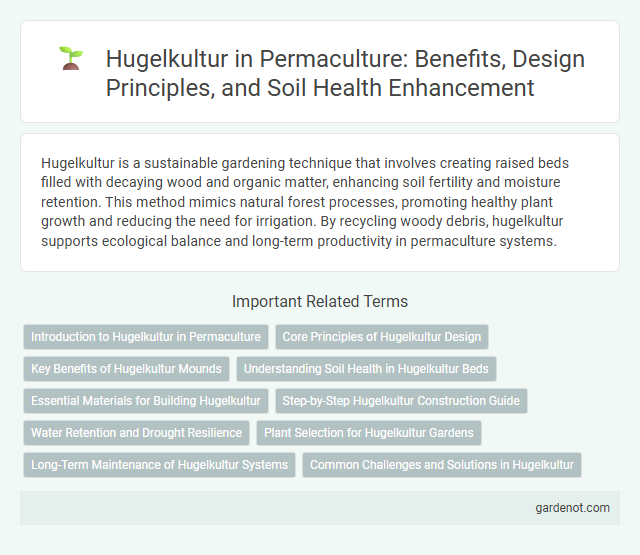Hugelkultur is a sustainable gardening technique that involves creating raised beds filled with decaying wood and organic matter, enhancing soil fertility and moisture retention. This method mimics natural forest processes, promoting healthy plant growth and reducing the need for irrigation. By recycling woody debris, hugelkultur supports ecological balance and long-term productivity in permaculture systems.
Introduction to Hugelkultur in Permaculture
Hugelkultur is a permaculture technique involving the creation of raised garden beds using decomposing wood and organic matter. This method enhances soil fertility, water retention, and microbial activity, promoting sustainable plant growth. Integrating Hugelkultur into permaculture designs supports ecosystem resilience and reduces water usage.
Core Principles of Hugelkultur Design
Hugelkultur design centers on core principles such as maximizing soil fertility through the strategic layering of decomposing wood, organic matter, and soil, which enhances moisture retention and nutrient cycling. This method mimics natural forest processes by creating elevated garden beds that improve aeration and drainage while fostering beneficial microbial activity. The integration of carbon-rich woody debris acts as a sustained nutrient source, supporting plant growth and promoting long-term ecosystem resilience.
Key Benefits of Hugelkultur Mounds
Hugelkultur mounds enhance soil fertility by decomposing wood slowly, providing long-term nutrient release and improving moisture retention in garden beds. These raised beds increase water efficiency, reducing irrigation needs by capturing and storing rainwater effectively. Elevated soil temperatures in hugelkultur mounds enable extended growing seasons and support diverse plant health in permaculture systems.
Understanding Soil Health in Hugelkultur Beds
Hugelkultur beds enhance soil health by improving moisture retention, aeration, and nutrient cycling through decomposing wood layers beneath the soil surface. The decaying organic matter fosters beneficial microbial activity and increases humus content, promoting robust plant growth. Understanding these processes helps optimize soil fertility and sustainability in permaculture systems.
Essential Materials for Building Hugelkultur
Essential materials for building hugelkultur include decomposing wood, branches, twigs, and organic debris, providing a robust nutrient reservoir and moisture retention system. Layers of compost, topsoil, and mulch are applied to enhance soil fertility and microbial activity, promoting healthy plant growth. Selecting a mix of hardwood and softwood enhances decomposition rates, ensuring long-term soil enrichment and moisture regulation.
Step-by-Step Hugelkultur Construction Guide
Hugelkultur construction begins by selecting a site and digging a shallow trench to improve drainage and root growth. Next, layers of logs, branches, and twigs are placed in the trench, forming the core structure that slowly decomposes and enriches the soil. The mound is then covered with organic materials such as compost, topsoil, and mulch to create a nutrient-rich environment that retains moisture and supports diverse plant growth.
Water Retention and Drought Resilience
Hugelkultur enhances water retention by using decomposing wood and organic matter to create a sponge-like soil structure that absorbs and holds moisture effectively. This technique improves drought resilience by maintaining consistent soil hydration, reducing the need for frequent irrigation, and supporting healthy plant growth during dry periods. The elevated beds also promote better aeration and nutrient cycling, further boosting ecosystem stability in permaculture gardens.
Plant Selection for Hugelkultur Gardens
Selecting plants for hugelkultur gardens involves prioritizing species that thrive in well-drained, nutrient-rich, and moisture-retentive soil environments created by decomposing wood mounds. Deep-rooted perennials such as comfrey, berries, and nitrogen-fixing legumes like clover enhance soil fertility and structure while stabilizing the mound. Incorporating a mix of sun-loving and shade-tolerant plants optimizes growth across the varying microclimates on different sides of the hugelkultur bed.
Long-Term Maintenance of Hugelkultur Systems
Hugelkultur beds require minimal long-term maintenance due to their self-sustaining design, which relies on decomposing wood to retain moisture and enrich soil. Over time, the wood breaks down, improving soil structure and nutrient availability, reducing the need for supplemental watering and fertilization. Regular addition of organic mulch and occasional top-up of woody material ensures continued soil fertility and moisture retention in the system.
Common Challenges and Solutions in Hugelkultur
Hugelkultur beds often face challenges such as slow decomposition of large woody materials, resulting in uneven nutrient release and initial nitrogen immobilization. To address this, incorporating smaller organic matter and nitrogen-rich amendments like compost or manure can accelerate microbial activity and balance nutrient availability. Ensuring proper moisture retention through strategic layering and mulch application helps prevent drying out, promoting consistent plant growth and soil health in hugelkultur systems.
Hugelkultur Infographic

 gardenot.com
gardenot.com